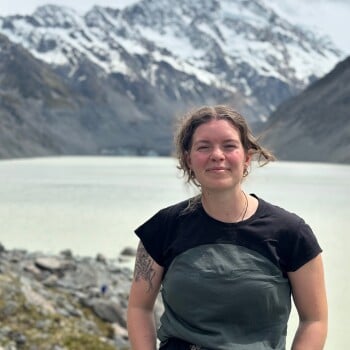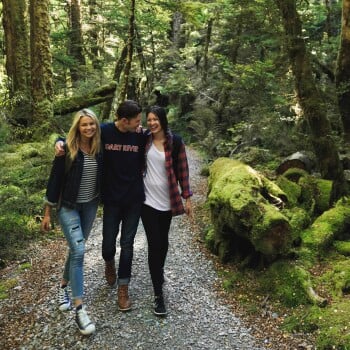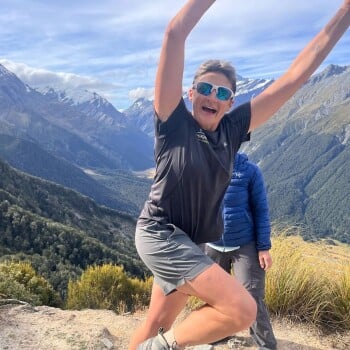- About Us
-
Trips
-
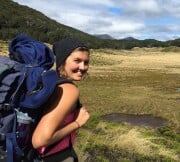 Kiwi-Style Hiking
Kiwi-Style Hiking
-
 Great Walks
Great Walks
-
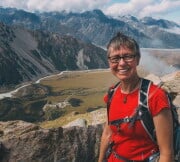 Hiking Tours
Hiking Tours
-
Alpine Hikes
-
Custom Groups
- Huayhuash Trek
- Family Northern Explorer
- Family Southern Explorer
- Lake Waikaremoana Hike
- Women's Custom Tours
- Women's Southern Wilderness
- Coast, Canyons and Mountains
- Coastal Wanderer Custom Tour
- Don't Cross the Ladies
- Secret South Custom Tour
- Tekapo Hike
- West Coast Custom Tour
- World Heritage Custom Tour
-
- Blog
- Shortlist
- About Us
- Trips
- Blog
- Shortlist

Feb 1, 2002
Student Anita Lee gets out of the city and into the wild on the West Coast Wilderness.
As a city slacker I hadn't much experience of wet socks or the wilderness. That all changed in May this year when I found myself scrambling over limestone rocks, wading through rivers, jumping from heights and sleeping in a West Coast cave at high tide. And all in one day. For 10 days I was one of five who roamed wild from Nelson to Queenstown on a Hiking New Zealand trip.
Mark Brabyn, a trained zoologist, is the founder of the Hiking New Zealand, set up 9 years ago. The aim was to promote the natural aspects of this country, its mountains, rivers and birds. For Mark it was a conscious move away from the high adventure packages such as bungy jumping and jet-boating. "To me that's not the real New Zealand".
Inspiration came from Mark's own safari experiences in Africa and Alaska. He spent three months studying Elephants for Uganda's Institute of Ecology. He also studied Chimpanzees which involved "climbing tree's with them". Experience in running backpacking tours also helped.
On this journey of discovery Mark took with him Malcolm, an experienced tramper from Wellington, Kate, a Yorkshire woman with a tireless stride (much to my envy), Jacob, Dane, with an impressive grasp of Kiwi slang, particularly in certain situations, and myself, a journalism student from Canterbury University.
First on the programme was a four-hour hike along an old pack track in Kahurangi National Park. Flora track, is wide and easygoing - a "warm up" Mark told us. We tramped through the beach forest while Mark pointed out various plants and birds of interest, including a flock of ten Riflemen.
Forget microwaves, electric blankets and colour co-ordinated socks, this trip is back to basics. We collected our own firewood and cooked our food with immense energy.
We slept under a rock overhang fringed with beech trees. It was the first time I had ever slept under the open sky with mountains as bedposts. The hum of the previous night's Nelson traffic was replaced by the stillness of the land, disturbed only by a weka, that managed to peck at our food before being chased away.
Our next stop at Fox River
This tramp was our first real taste of 'river wading'. I quickly reconsidered my ideal that tramping boots should be kept warm and dry at all costs and took the plunge. We weaved across the river until we reached the ballroom rock overhang.
On arrival we scavenged for firewood and carried it back to base looking rather like 15th century peasants by that stage. That evening after filling our bellies and building a fire we sat with other fellow trampers singing songs as Kate and I watched our dirty wet socks steam by the fire.
On our way out of the Fox, Mark took us to some nearby caves. We plunged into darkness and into another world. The path went for about 1500m. The smooth, cream calcium-covered rocks were in stark contrast to the mountains outside and the sounds of the Fox were replaced by a still drip of water.
And so we continued South..
Okarito, where Keri Hulme lives and set her book "The Bone People", is wild, beautiful and isolated. We climbed up to the Okarito trig. From here we could see the rugged coast, the lagoon, all framed by the Alps and native rain forest.
We collected firewood on the beach and that night we lit a fire and drank wine. I slept with the roar of the sea in my ears and loose gravel in the bottom of my sleeping bag.
Carbon dated
We replaced our packs with lifejackets and changed boots for kayaks. Okarito lagoon, which is a maze of marshland and water channels, is half salt water, half fresh water. We paddled in the sea and observed the abundant bird life, notably the white heron or kotuku.
The clouds tentatively lifted, allowing us to peek at Mts. Cook and Tasman.
That night, at Franz Josef Township, we experienced another kind of wildlife. The locals. In their Swandri's and gumboots they were as much a part of the coast as the mountains outside. One old timer, Max, claimed his family had been there for 2000 years, "carbon dated".
After exploring the Franz Josef glacier we prepared ourselves for our last major tramp through the Copland valley to Welcome flats hut. The day was warm. Wood pigeons and other birds flew overhead. We were lucky to see rare blue duck waddle along the riverbank. The hut, aptly named I felt by this stage, stood proudly surrounded by snow capped mountains. We didn't waste any time. Off went our clothes and into the hot pools went our weary bones.
The sun moved on and the rain lashed out for the next two days causing the river to swell, waterfalls to emerge and tracks to turn to mud. Feeling supremely confident we decided to do some river crossing.
One look at them, however, and instead of proceeding we went back to the hut. That evening we slouched in the pools as the rain poured down. Mist floated over the mountains while we created slimy green mud sculptures and enjoyed the peace of this place.
The next day we climbed part way up Brewsters Range. We passed through beech trees until they got smaller and smaller, reminiscent of a goblin forest. After climbing through icy tussock we were rewarded with an extensive view over the Alps where we could see Mt Aspiring in the background. "Floating castles" Jacob called them.
Back in Civilisation
It seemed strange to be back in 'civilisation'. There was something not quite real about Queenstown after having been bush. It was like a Hollywood set and tourists, actors waiting for a scene to begin. Instead of hovering over a billy we sat in swanky coffee bars. Malcolm, with wild unkempt hair and five-day stubble looked quite mad against the clean white coffee cups and sophisticated artwork.
That's where we all split up. It was sad, as we were a tight knit group by this stage. For Kate and Jacob it was a great way to roam New Zealand. For me; well it made me think about the simple things in life, clean air, beautiful scenery, exercise and spending time with people you like.
Having not known a Tui from a Wood Pigeon, or from anything else for that matter, it was an education in the variety of our wildlife. Being a city dweller you forget what is in your own backyard.


